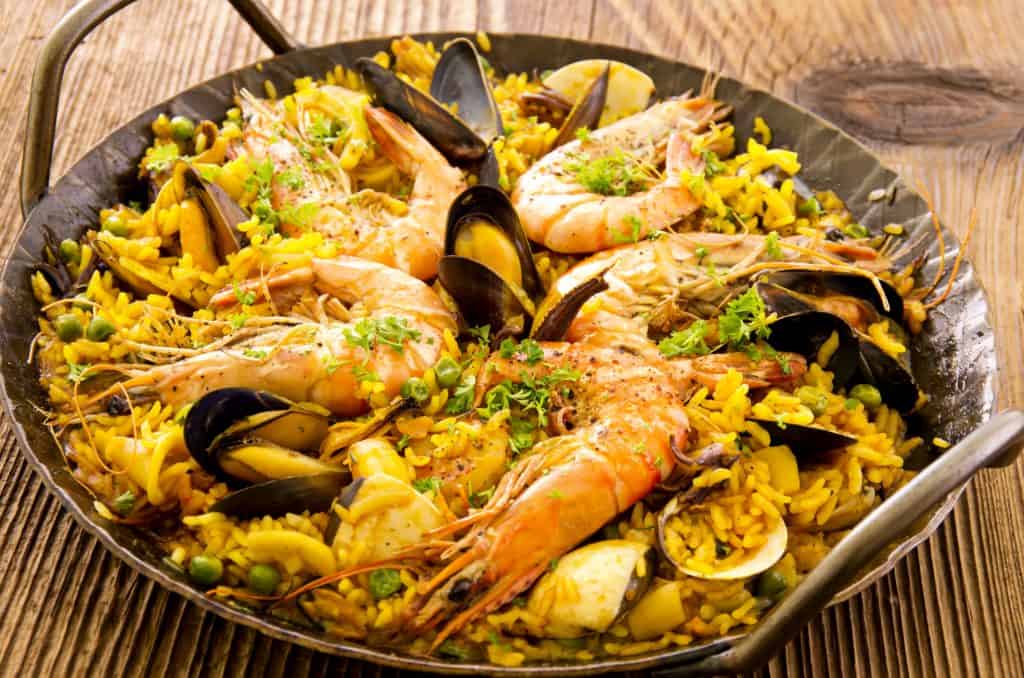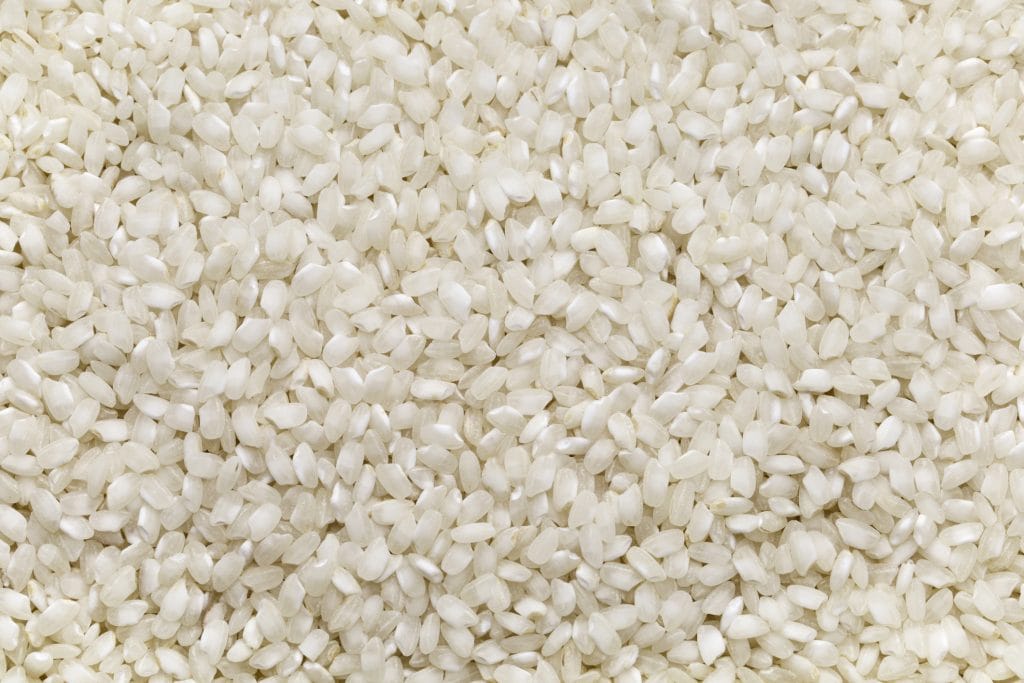Do you think that paella rice looks like risotto rice? Is paella rice the same as risotto rice?
I always got confused between paella rice varieties and risotto rice varieties. After all, they look similar due to their short and round characteristics. They also have a high starch content responsible for turning them sticky after cooking.
Now, the question is whether both are the same or not. Let’s get into this blog post to understand the differences!
Paella rice is different from risotto rice. Paella rice is a broad term used for Spanish rice varieties, like Bomba and Calasparra, whereas risotto rice is a term used for Italian rice varieties, like Arborio. Once cooked, paella rice has a dry and fluffy texture, whereas cooked risotto rice is creamy.
Comparison Table: Paella Rice Vs. Risotto Rice
| Category | Paella Rice | Risotto Rice |
| Origin | Spain | Italy |
| Type of Rice | Bomba (mainly), Senia, Bahia, and Calasparra | Arborio, Carnaroli, and Vialone Nano |
| Texture (after cooking) | Dry and fluffy | Creamy and sticky |
| Cooking Method | No stirring involved | Stirring involved |
| Seasonings | Paprika, cayenne, saffron, lemon zest | Butter, parmesan cheese, parsley |
| Broth Requirements | Three cups for one cup of paella rice | Four to five cups for one cup of risotto rice |
Are Paella and Risotto Rice the Same?
You won’t realize the differences between paella and risotto rice until you cook something with them.
I remember cooking paella and risotto consecutively over a weekend. During this time, I discovered the major and minor differences between the two rice varieties.
1. Origin
The primary difference between paella rice and risotto rice is their countries of origin.
Paella is a popular dish originating from Spain. Bomba, for example, is a famous rice variety used for making paella that is cultivated in the eastern part of Spain.
On the other hand, risotto has Italian origins, so it consists of rice varieties, like Arborio, grown in Italy.
2. Type of Rice
Paella rice and risotto rice are not rice varieties. Instead, they are rice-based dishes from two different countries. Because of this reason, the type of rice used for their preparation varies.

Paella rice is a broad term for Spanish rice varieties like Bomba (mainly), Senia, Bahia, and Calasparra. The next time you see a packet of Paella rice, there is a good chance it is Bomba rice!

Similarly, risotto rice is a term used to describe three main types of Italian rice: Arborio, Carnaroli, and Vialone Nano.
3. Texture
The texture is one of the most significant differences between paella rice and risotto rice.
Both paella and risotto rice varieties have common characteristics. For instance, Bomba (paella rice) and Arborio (risotto rice) are short, have a high starch content, and can absorb a lot of water.
However, you see a massive difference between the texture of paella rice and risotto rice after cooking.
Cooked paella rice has a dry texture where each rice grain is separate. On the contrary, cooked risotto rice has a creamy consistency where the rice grains stick together.
4. Cooking Method
In paella and risotto, you cannot use precooked or leftover rice. Instead, you have to cook the raw rice grains with the other ingredients in a broth. This is where the similarities in their cooking methods end.
Paella rice requires a shallow and wide pan called a “paellera.”

The whole point of a paella pan is to allow you to spread a thin and even layer of rice. When cooking, this forms a crispy layer of rice near the pan’s bottom, known as “socarrat!” To ensure that the rice turns crispy, no stirring is involved when making paella.
If you have seen risotto, you will know that risotto rice has to turn creamy and smooth. You need to stir it every 30 seconds to release the starch from the grains, which is responsible for adding the creaminess.
6. Cooking Time and Broth Required
Both paella rice and risotto rice take time to cook since they are not boiled beforehand.
Generally, risotto rice takes at least 20 to 25 minutes to fluff up and absorb the flavors. You need four cups of broth for one cup of risotto rice. This measurement may change slightly depending on the type of rice that you use.
Paella rice has a long cooking time, which ranges between 15 and 30 minutes. You need 2 ½ to 3 cups of broth for one cup of paella rice. Paella requires less broth than risotto rice.
5. Seasonings and Appearance
Spanish cuisine is known for its seasoned dishes, while Italian cuisine is famous for its simplicity. As a result, you will find a vast difference between the seasonings used for paella rice and risotto rice.
Paella rice is infused with potent ingredients like paprika, saffron, cumin, cayenne pepper, and lemon zest.
On the other hand, risotto rice is usually paired with two to three mild-flavored ingredients, such as butter, parmesan cheese, and parsley.
Can You Use Paella Rice for Risotto?

I prefer using Italian rice varieties, like Arborio or Carnaroli, for risotto because of their starchy nature. It allows the rice to turn extra-creamy while cooking with broth. This way, I get the desired consistency in my dish!
However, risotto rice varieties are sometimes more expensive and difficult to find in some areas. If this is the case, you can opt for rice alternatives that contain a lot of starch, like Calrose.
Paella rice varieties, including Bomba and Calasparra, are excellent substitutes for risotto rice. They contain almost the same amount of starch as Arborio and have a high water absorption rate. This characteristic allows them to soak in the broth, absorb all the flavors, and turn creamy.
Note that you might have to add extra cream to get a consistency similar to Arborio risotto.
How Can You Make Risotto Using Paella Rice?
Since you know that you can use paella rice for risotto, here is my favorite recipe.
Ingredients
- 1 cup of uncooked Bomba (Paella) rice
- 2 tablespoons of extra virgin olive oil
- 3 to 4 sliced garlic cloves
- 2 ½ cups of vegetable or chicken stock
- 1 cup of white wine (or one tablespoon of lemon juice)
- ½ cup of heavy cream
- Salt and pepper (to taste)
- 3 sliced mushrooms (optional)
Cooking Instructions
- Start by heating a pan on medium-high heat.
- Add two tablespoons of extra virgin olive oil and sauté the sliced garlic.
- Once the garlic turns brown, add the mushrooms and sauté them well for five minutes.
- Then, add one cup of Bomba rice grains to the pan. Toast them in the oil for two to three minutes at low heat.
- Add one cup of stock to the rice and give it a good stir.
- Let the rice cook until it absorbs the stock. Stir the mixture at least once every minute while it is cooking.
- After the rice has absorbed the stock, add one cup of wine or one tablespoon of lemon.
- Then, stir again for a few seconds and pour the remaining stock into the cooking pot.
- Allow the rice grains to cook until they swell up and are al dente.
- Once the rice is cooked, add half a cup of cream, plus salt and pepper to taste.
- Finally, add two tablespoons of butter, parmesan cheese, and parsley.
- Combine everything well, and you are good to go!
Quick Note: Always use unwashed Bomba rice grains for risotto. If you rinse them before use, the starch comes off, which results in a less creamy texture.
Final Thoughts
Paella and risotto rice varieties may have similar appearances and starch content when uncooked.
However, the countries they originate from and the cooking methods they require are entirely different. Paella rice is drier with a fluffy texture, whereas risotto rice is known to be creamy and rich. Therefore, you have to pick one depending on your dish’s requirements.

